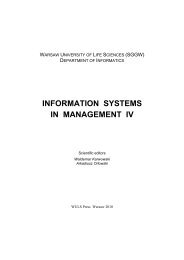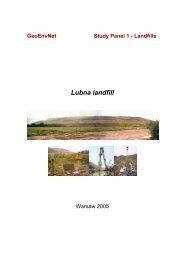ACTA SCIENTIARUM POLONORUM - SGGW
ACTA SCIENTIARUM POLONORUM - SGGW
ACTA SCIENTIARUM POLONORUM - SGGW
Create successful ePaper yourself
Turn your PDF publications into a flip-book with our unique Google optimized e-Paper software.
26 R. Hryniewski, W. Mądry, D. Gozdowski, B. Roszkowska-MądraTable 2. Statistical parameters for the 15 diagnostic variables of the surveyed tobacco farmsTabela 2. Parametry statystyczne 15 zmiennych w zbiorze badanych gospodarstw tytoniowychVariabledesignationVariable MeanMinimum(Min.)Maximum(Max.)Standarddeviation(SD)Coefficientof variation(CV%)X1 Soil quality 4.09 2.00 5.70 0.76 18.7X2 Share of grasslands 18.05 0.00 58.00 13.55 75.1X3 Level of education 2.24 1.00 5.00 0.86 38.5X4 No. of agricultural workers 0.26 0.05 1.05 0.18 67.5X5 No. of innovations 0.93 0.00 22.00 2.70 140.1X6 Farm area 8.62 1.40 37.80 5.14 59.6X7 Share of cereals 58.50 0.00 92.65 21.14 36.1X8 Share of tobacco 31.34 3.89 100.00 20.38 65.0X9 Cattle density 0.25 0.00 2.01 0.31 124.6X10 Organic fertilizer use 4.21 0.00 30.00 4.26 101.2X11 NPK fertilizer use 122.11 0.00 402.00 71.61 58.6X12 Production intensity index 0.22 0.03 0.51 0.09 42.7X13 Yield of tobacco leaves 2.43 0.90 4.10 0.56 23.2X14X15Source:Źródło:Contribution of agricultural productionto farm household incomesContribution of tobacco productionto farm incomesAuthor’s elaboration.Opracowanie własne.75.96 20.00 100.00 24.13 31.882.95 5.00 100.00 16.88 20.3Many studies on the diversity of farming systems indicate that farm area and thelivestock density (mainly of cattle) are among the most important diagnostic variablesdescribing the farming systems and the determinants of their ability to undergo adaptivetransformations [Damianos and Skuras 1996, Kristensen 2003, Serrano Martínez et al.2004a, Paul and Nehring 2005, Iraizoz et al. 2007, Carmona et al. 2010].The first principal component defines the gradient of the farming systems intensificationin tobacco farms within south-eastern Poland; the gradient is positively correlatedwith the production intensity attributes and negatively correlated with contribution of tobaccoproduction to total farm incomes being diagnostic variables mostly discriminatingthe farms. It thus appears that large farms with more intensive and diversified, effectiveagricultural production derive their farm income from growing tobacco to a relativelysmaller extent than farms using diametrically different production systems. This alsomeans that incomes and development perspectives of large and intensive farms wouldbe not likely to suffer much if they reduced or abandoned the production of tobacco. Onthe other hand, reducing or abandonment of growing tobacco in small, extensive farmswith a poorly developed agricultural function may be a causal factor of a serious threatto their socio-economic and environmental viability and survival. The threat could bediminished or eliminated if those farms made appropriate adjustment of their farmingsystems through technical or structural change, agricultural and on-farm non-agriculturaldiversification, increased product value-added, or engagement with local and regionalActa Sci. Pol.
















